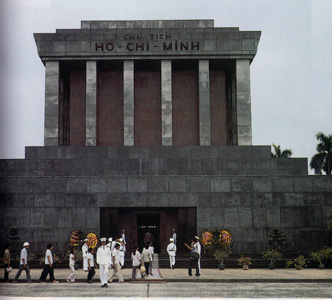- Hanoi
- Hue
- Saigon
- Map of Vietnam

Built on the former site of the ancient city of Dai la, on the riverbank of the Song Hong (Red River), Hanoi, the historical and political capital of unified Vietnam, was the name Emperor Minh Mang gave to the ancient capital of Thang Long founded in 1010 by King Ly Thai To. According to Legend, on his arrival in Dai La the King saw an enormous golden dragon emerge from the lake and soar into the sky above the site of the future capital. On the strength of this he decided to move the capital from Hoa Lu to Dai La which he renamed Thang Long (Ascending Dragon). Hanoi's later less inspired name, Dong Kinh (Capital of the East) became Tunquin after Alexandre de Rhodes Latinised written Vietnamese. The name finally became Tonkin courtesy of the French colonial administration that used it to refer to the entire North of Vietnam during the colonial era. In Vietnamese, Hanoi is usually written as two words, Ha meaning river, in reference to the Red River and Noi meaning this (inner) side.
 When Hanoi fell into the hands of the French in 1882 the city underwent considerable
transformation and modernization. The face of Hanoi acquired an appearance reflecting a
harmony between progress and tradition, although this harmony did not extend to the relations
between the Vietnamese and their French overseers. The substantial architectural legacy
left behind by the French includes the Doumer bridge, the cathedral, Dong Xuan Market, the
French School d'Extreme Orient, the Louis Finot Museum, Hanoi University, several hotels,
Many beautiful colonial villas and an opera house.
When Hanoi fell into the hands of the French in 1882 the city underwent considerable
transformation and modernization. The face of Hanoi acquired an appearance reflecting a
harmony between progress and tradition, although this harmony did not extend to the relations
between the Vietnamese and their French overseers. The substantial architectural legacy
left behind by the French includes the Doumer bridge, the cathedral, Dong Xuan Market, the
French School d'Extreme Orient, the Louis Finot Museum, Hanoi University, several hotels,
Many beautiful colonial villas and an opera house.
Hanoi's population is about 3,057,000 and extends over 825 square miles. The city centre comprises four districts: Hoan Kiem (the Restored Sword), Hai Ba Trung (the Two Trung Sisters), Dong Da (where King Quang Trung defeated the Manchu invasion in 1789) and Ba Dinh. It also incorporates eleven recently integrated suburban districts (quan): Thanh Tri, Tu Liem, Dong Anh, Gia Lam, Ba Vich, Thach That, Phuc Tho, Hoai Duc, Dan Phuong, Me Linh and Soc Son.
Hanoi is greatly know for being Vietnam's capital and the great Ho Chi Minh mausoleum. His embalmed corpse lies in a glass casket within the monumental tomb. The place is usually closed for two months while his body is packed off to Russia for an overhaul. The construction of the mausoleum began in September 1973 and finished in August 1975. Ho Chi Minh's embalmed body lies on top of a platform in a cold room within.
